Jun'ichirō Tanizaki
| Tanizaki Jun'ichirō | |
|---|---|
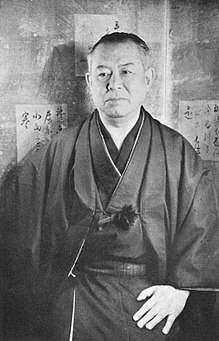 Tanizaki in 1951 | |
| Native name | 谷崎 潤一郎 |
| Born |
24 July 1886 Nihonbashi, Tokyo, Japan |
| Died |
30 July 1965 (aged 79) Yugawara, Kanagawa, Japan |
| Occupation | Writer |
| Genre | fiction, drama, essays, silent film scenarios |
Jun'ichirō Tanizaki (谷崎 潤一郎 Tanizaki Jun'ichirō, 24 July 1886 – 30 July 1965) was one of the major writers of modern Japanese literature, and perhaps the most popular Japanese novelist after Natsume Sōseki. Some of his works present a shocking world of sexuality and destructive erotic obsessions. Others, less sensational, subtly portray the dynamics of family life in the context of the rapid changes in 20th-century Japanese society. Frequently his stories are narrated in the context of a search for cultural identity in which constructions of "the West" and "Japanese tradition" are juxtaposed.
He was one of six authors on the final shortlist for the Nobel Prize in Literature in 1964, the year before his death.[1][2]
Biography

Early life
Tanizaki was born into a well-to-do merchant class family in Nihonbashi, Tokyo, where his uncle owned a printing press, which had been established by his grandfather. Tanizaki described his admittedly pampered childhood in his Yōshō Jidai (Childhood Years, 1956). His childhood home was destroyed in the 1894 Meiji Tokyo earthquake, to which Tanizaki later attributed his lifelong fear of earthquakes. His family's finances declined dramatically as he grew older until he was forced to reside in another household as a tutor.
Despite these financial problems, he attended the Tokyo First Middle School, where he became acquainted with Isamu Yoshii. Tanizaki attended the Literature Department of Tokyo Imperial University from 1908, but was forced to drop out in 1911 because of his inability to pay for tuition.
Early literary career
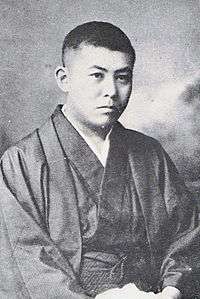
Tanizaki began his literary career in 1909. His first work, a one-act stage play, was published in a literary magazine that he had helped found. Tanizaki's name first became widely known with the publication of the short story Shisei ("The Tattooer") in 1910. In the story, a tattoo artist inscribes a giant spider on the body of a beautiful young woman. Afterwards, the woman's beauty takes on a demonic, compelling power, in which eroticism is combined with sado-masochism. The femme-fatale is a theme repeated in many of Tanizaki's early works, including Kirin (1910), Shonen ("The Children", 1911), Himitsu ("The Secret," 1911), and Akuma ("Devil", 1912). Tanizaki's other works published in the Taishō period include Shindo (1916) and Oni no men (1916), which are partly autobiographical.
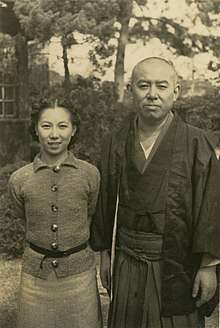
Tanizaki married his first wife, Chiyoko, in 1915, and his first child, a daughter, was born in 1916. However, it was an unhappy marriage, and in time he encouraged a relationship between Chiyoko and his friend and fellow writer Haruo Satō. The psychological stress of this situation is reflected in some of his early works, including the stage play Aisureba koso (Because I Love Her, 1921) and the novel Kami to hito no aida (Between Men and the Gods, 1924). Even though some of Tanizaki's writings seem to have been inspired by these and other persons and events in his life, his works are far less autobiographical than those of most of his contemporaries in Japan.
In 1918, Tanizaki toured Korea, northern China and Manchuria. In his early years he became infatuated with the West and all things modern. In 1922, he relocated from Odawara, where he had been living since 1919, to Yokohama, which had a large expatriate population, living briefly in a Western-style house and leading a decidedly bohemian lifestyle. This outlook is reflected in some of his early writings.
Tanizaki had a brief career in silent cinema, working as a script writer for the Taikatsu film studio. He was a supporter of the Pure Film Movement and was instrumental in bringing modernist themes to Japanese film.[3] He wrote the scripts for the films Amateur Club (1922) and A Serpent's Lust (1923) (based on the story of the same title by Ueda Akinari, which was, in part, the inspiration for Mizoguchi Kenji's 1953 masterpiece Ugetsu monogatari). Some have argued that Tanizaki's relation to cinema is important to understanding his overall career.[4]
Period in Kyoto
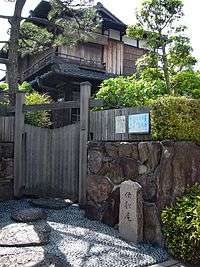
Tanizaki's reputation began to take off in 1923, when he moved to Kyoto after the Great Kanto earthquake, which destroyed his house in Yokohama (at the time Tanizaki was on a bus in Hakone and thus escaped injury). The loss of Tokyo's historic buildings and neighborhoods in the quake triggered a change in his enthusiasms, as he redirected his youthful love for the imagined West and modernity into a renewed interest in Japanese aesthetics and culture, particularly the culture of the Kansai region (around the cities of Osaka, Kobe and Kyoto). His first novel after the earthquake, and his first truly successful novel, was Chijin no ai (Naomi, 1924-25), which is a tragicomic exploration of class, sexual obsession, and cultural identity. Tanizaki made another trip to China in 1926, where he met Guo Moruo, with whom he later maintained correspondence. He relocated from Kyoto to Kobe in 1928.
Inspired by the Osaka dialect, Tanizaki wrote Manji (Quicksand, 1928–1929), in which he explored lesbianism, among other themes. This was followed by the classic Tade kuu mushi (Some Prefer Nettles, 1928–29), which depicts the gradual self-discovery of a Tokyo man living near Osaka, in relation to Western-influenced modernization and Japanese tradition. Yoshinokuzu ("Arrowroot", 1931) alludes to Bunraku and kabuki theater and other traditional forms even as it adapts a European narrative-within-a-narrative technique. His experimentation with narrative styles continued with Ashikari ("The Reed Cutter," 1932), Shunkinsho ("A Portrait of Shunkin", 1933), and many other works that combine traditional aesthetics with Tanizaki's particular obsessions.
His renewed interest in classical Japanese literature culminated in his multiple translations into modern Japanese of the eleventh-century classic The Tale of Genji and in his masterpiece Sasameyuki (literally "A Light Snowfall," but published in English translation as The Makioka Sisters, 1943–1948), a detailed characterization of four daughters of a wealthy Osaka merchant family who see their way of life slipping away in the early years of World War II. The sisters live a cosmopolitan life with European neighbors and friends, without suffering the cultural-identity crises common to earlier Tanizaki characters. When he began to serialize the novel, the editors of Chūōkōron were warned that it did not contribute to the needed war spirit and, fearful of losing supplies of paper, cut off the serialization.[5]
Tanizaki relocated to the resort town of Atami, Shizuoka in 1942, but returned to Kyoto in 1946.
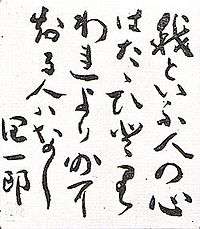
Postwar period
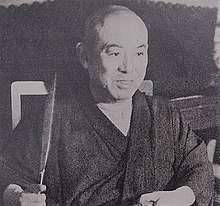
After World War II, Tanizaki again emerged into literary prominence, winning a host of awards. Until his death, he was widely regarded as Japan's greatest contemporary author. He won the prestigious Asahi Prize in 1949, was awarded the Order of Culture by the Japanese government in 1949, and in 1964 was elected to honorary membership in the American Academy and Institute of Arts and Letters, the first Japanese writer to be so honoured.
His first major post-war work was Shōshō Shigemoto no haha ("Captain Shigemoto's Mother," 1949–1950), which includes a restatement of Tanizaki's frequent theme of a son's longing for his mother. The novel also introduces a new theme, of sexuality in old age, which reappears in later works such as Kagi (The Key, 1956). Kagi is a psychological novel in which an aging professor arranges for his wife to commit adultery in order to boost his own sagging sexual desires.
Tanizaki returned to Atami in 1950, and was designated a Person of Cultural Merit by the Japanese government in 1952. He suffered from paralysis of the right hand from 1958, and was hospitalized for Angina pectoris in 1960.
Tanizaki's characters are often driven by obsessive erotic desires. In one of his last novels, Futen Rojin Nikki (Diary of a Mad Old Man, 1961–1962), the aged diarist is struck down by a stroke brought on by an excess of sexual excitement. He records both his past desires and his current efforts to bribe his daughter-in-law to provide sexual titillation in return for Western baubles.
In 1964, Tanizaki moved to Yugawara, Kanagawa, southwest of Tokyo, where he died of a heart attack on 30 July 1965, shortly after celebrating his 79th birthday. His grave is at the temple of Hōnen-in in Kyoto.
Legacy
The Tanizaki Prize is one of Japan's most sought-after literary awards. Established in 1965 by the publishing company Chūō Kōronsha, it is awarded annually to a work of fiction or drama.
Bibliography
Selected works
| Year | Japanese Title | English Title | Notes |
| 1910 | 刺青 Shisei |
"The Tattooer" | |
| 1913 | 恐怖 Kyōfu |
"Terror" | A short story of a young man suffering of the fear of trains |
| 1918 | 金と銀 Kin to Gin |
"Gold and Silver" | |
| 1919 | 富美子の足 Fumiko no ashi |
"Fumiko's Legs" | |
| 1921 | 私 Watakushi |
"The Thief" | |
| 1922 | 青い花 Aoi hana |
"Aguri" | |
| 1924 | 痴人の愛 Chijin no Ai |
Naomi | a.k.a. A Fool's Love |
| 1926 | 友田と松永の話 Tomoda to Matsunaga no hanashi |
"The Strange Case of Tomoda and Matsunaga" | |
| 1926 | 青塚氏の話 Aotsukashi no hanashi |
"Mr. Bluemound" | |
| 1928– 1930 |
卍 Manji |
Quicksand | Several film adaptations (1964, 1983, 1998 & 2006) |
| 1929 | 蓼喰う蟲 Tade kuu mushi |
Some Prefer Nettles | |
| 1931 | 吉野葛 Yoshino kuzu |
Arrowroot | |
| 1932 | 蘆刈 Ashikari |
The Reed Cutter | |
| 1933 | 春琴抄 Shunkinshō |
"A Portrait of Shunkin" | Film adaptation Opera adaptation |
| 陰翳礼讃 In'ei Raisan |
In Praise of Shadows | Essay on aesthetics | |
| 1935 | 武州公秘話 Bushukō Hiwa |
The Secret History of the Lord of Musashi | |
| 1936 | 猫と庄造と二人の女 Neko to Shōzō to Futari no Onna |
A Cat, A Man, and Two Women | Film adaptation |
| 1943– 1948 |
細雪 Sasameyuki |
The Makioka Sisters | Film adaptation |
| 1949 | 少将滋幹の母 Shōshō Shigemoto no haha |
Captain Shigemoto's Mother | |
| 1956 | 鍵 Kagi |
The Key | Film adaptation |
| 1957 | 幼少時代 Yōshō Jidai |
Childhood Years: A Memoir | |
| 1961 | 瘋癲老人日記 Fūten Rōjin Nikki |
Diary of a Mad Old Man | Film adaptation |
Works published in English
- Some Prefer Nettles, tr. Edward Seidensticker, Alfred A. Knopf 1955, Vintage Press 1995. ISBN 0-679-75269-2
- The Makioka Sisters, tr. Edward Seidensticker, Alfred A. Knopf 1957, Vintage Press 1995. ISBN 0-679-76164-0
- The Key and Diary of a Mad Old Man, tr. Howard Hibbert, Alfred A. Knopf 1960 and 1965 respectively, reissued in a single volume by Vintage Press 2004. ISBN 1-4000-7900-4
- Seven Japanese Tales, tr. Howard Hibbett, Alfred A. Knopf 1963. ISBN 0-679-76107-1
- In Praise of Shadows, tr. Thomas J. Harper and Edward G. Seidensticker, Leete's Island Books 1977, Charles E. Tuttle 1984.
- Naomi, tr. Anthony H. Chambers, Alfred A. Knopf 1985, Vintage Press 2001. ISBN 0-375-72474-5
- Childhood Years: A Memoir, tr. Paul McCarthy, Kodansha International 1988. ISBN 0-00-654450-9. Reissue forthcoming from the University of Michigan Press.
- A Cat, a Man, and Two Women, tr. Paul McCarthy, Kodansha International 1990. ISBN 4-7700-1605-0 Reissued by New Directions, 2016.
- The Secret History of the Lord of Musashi and Arrowroot, tr. Anthony H. Chambers, Alfred A. Knopf 1992, Vintage Press 2003. ISBN 0-375-71931-8
- Quicksand, tr. Howard Hibbett, Alfred A. Knopf 1993, Vintage Press 1995. ISBN 0-679-76022-9
- The Reed Cutter and Captain Shigemoto's Mother, tr. Anthony H. Chambers, Alfred A. Knopf 1993.
- The Gourmet Club: A Sextet, tr. Anthony H. Chambers and Paul McCarthy, Kodansha International 2001. ISBN 4-7700-2972-1. Reissued by the University of Michigan Press, 2017.
- Red Roofs and Other Stories, tr. Anthony H. Chambers and Paul McCarthy, University of Michigan Press, 2016.
- Devils in Daylight, tr. by J. Keith Vincent, New Directions, 2017.
- The Maids. tr. by Michael P. Cronin, New Directions, 2017
- "The Jester." tr. by Howard Hibbett. In A Tokyo Anthology: Literature from Japan’s Modern Metropolis, 1850-1915, ed. by Sumie Jones and Charles S. Inouye, pp. 268–280. University of Hawai’i Press, 2017.
- In Black and White, tr. by Phyllis I. Lyons, Columbia University Press (2018).
See also
- Torawakamaru the Koga Ninja
- Akuto, a film based on a Tanizaki story
References
- ↑ Nomination Database
- ↑ Four Japanese were nominees for ’64 Nobel literature prize: documents - Japan Times
- ↑ See Bernardi.
- ↑ See Lamarre.
- ↑ Jansen, Marius B. (2000). The Making of Modern Japan, p. 643.
Further reading

- Bernardi, Joanne (2001). Writing in Light: The Silent Scenario and the Japanese Pure Film Movement. Wayne State University Press. ISBN 0-8143-2926-8.
- Bienati, Luisa, and Bonaventura Ruperti, eds. The Grand Old Man and the Great Tradition: Essays on Tanizaki Jun'ichirō in Honor of Adriana Boscaro. University of Michigan Press (2009). ISBN 978-1-929280-55-1
- Boscaro, Adriana, et al., eds. Tanizaki in Western Languages: A Bibliography of Translations and Studies. University of Michigan Press (1999). ISBN 0-939512-99-8
- Boscaro, Adriana and Anthony Hood Chambers, eds. A Tanizaki Feast: The International Symposium in Venice. University of Michigan Press (1994). ISBN 0-939512-90-4
- Chambers, Anthony Hood. The Secret Window: Ideal Worlds in Tanizaki's Fiction. Harvard University Asia Centre (1994). ISBN 0-674-79674-8
- Chambers, Anthony Hood. Remembering Tanizaki Jun'ichiro and Matsuko: Diary Entries, Interview Notes, and Letters, 1954-1989. University of Michigan Press (2017). ISBN 978-0-472-07365-8
- Gessel, Van C. Three Modern Novelists. Kodansha International (1994). ISBN 4-7700-1652-2
- Ito, Ken Kenneth. Visions of Desire: Tanizaki's Fictional Worlds. Stanford University Press (1991). ISBN 0-8047-1869-5
- Jansen, Marius B. (2000). The Making of Modern Japan. Cambridge: Harvard University Press. ISBN 9780674003347; OCLC 44090600
- Keene, Donald. Dawn to the West. Columbia University Press (1998). ISBN 0-231-11435-4.
- Lamarre, Thomas (2005). Shadows on the Screen: Tanizaki Junʾichirō on Cinema and "Oriental" Aesthetics. Center for Japanese Studies, University of Michigan. ISBN 1-929280-32-7.
- Long, Margherita. This Perversion Called Love: Reading Tanizaki, Feminist Theory, and Freud. Stanford University Press (2009). ISBN 0804762333
External links
| Wikimedia Commons has media related to Tanizaki Junichiro. |